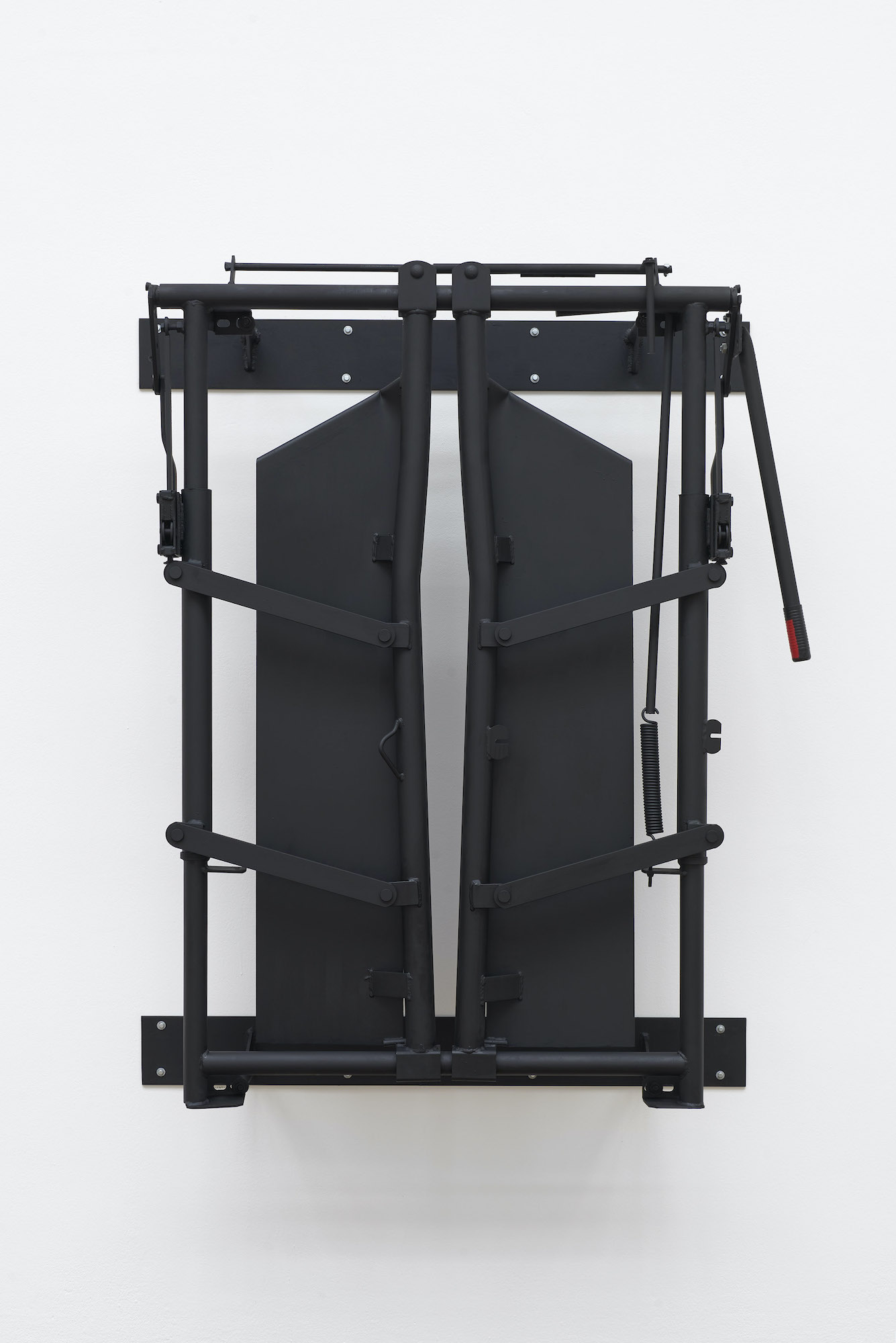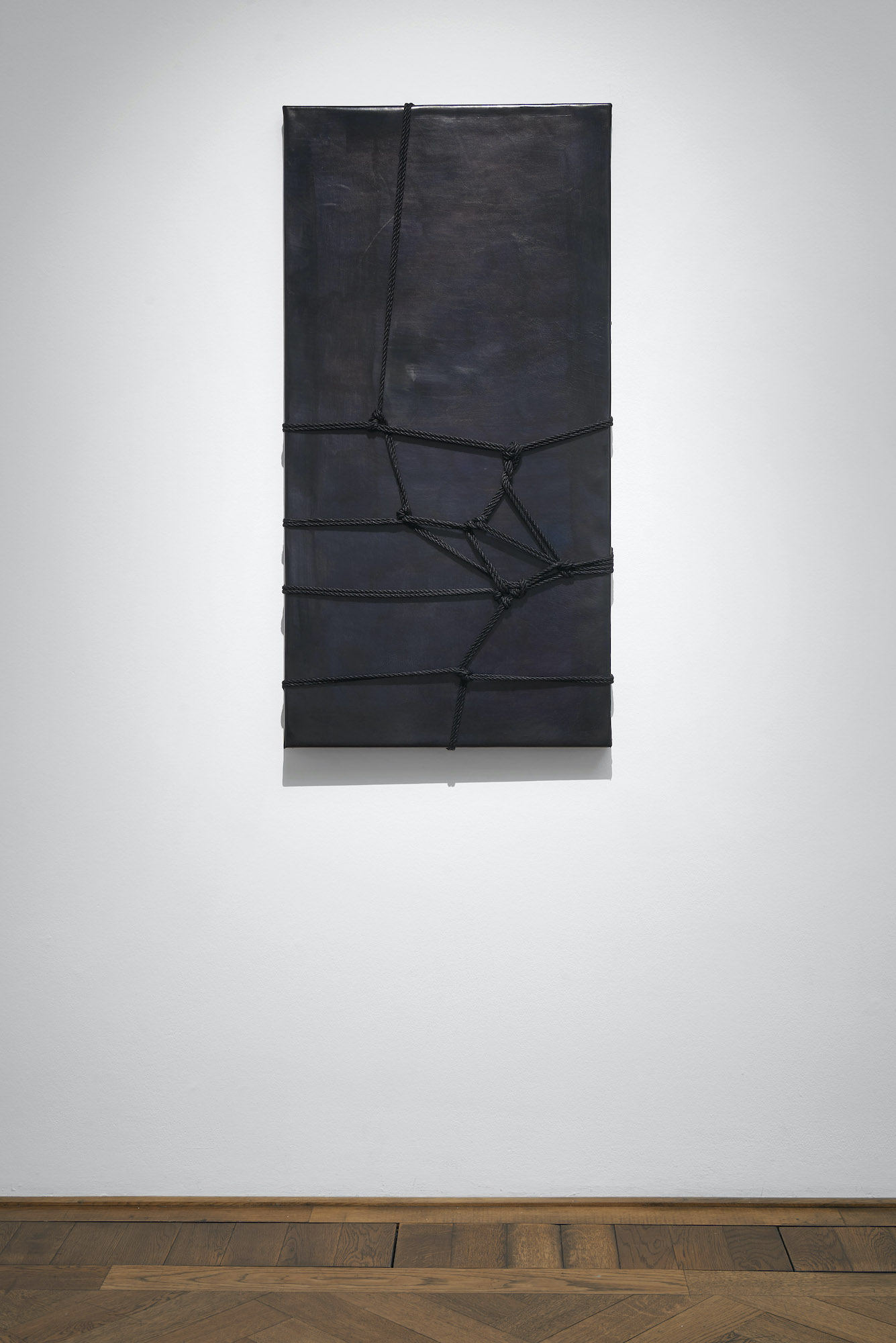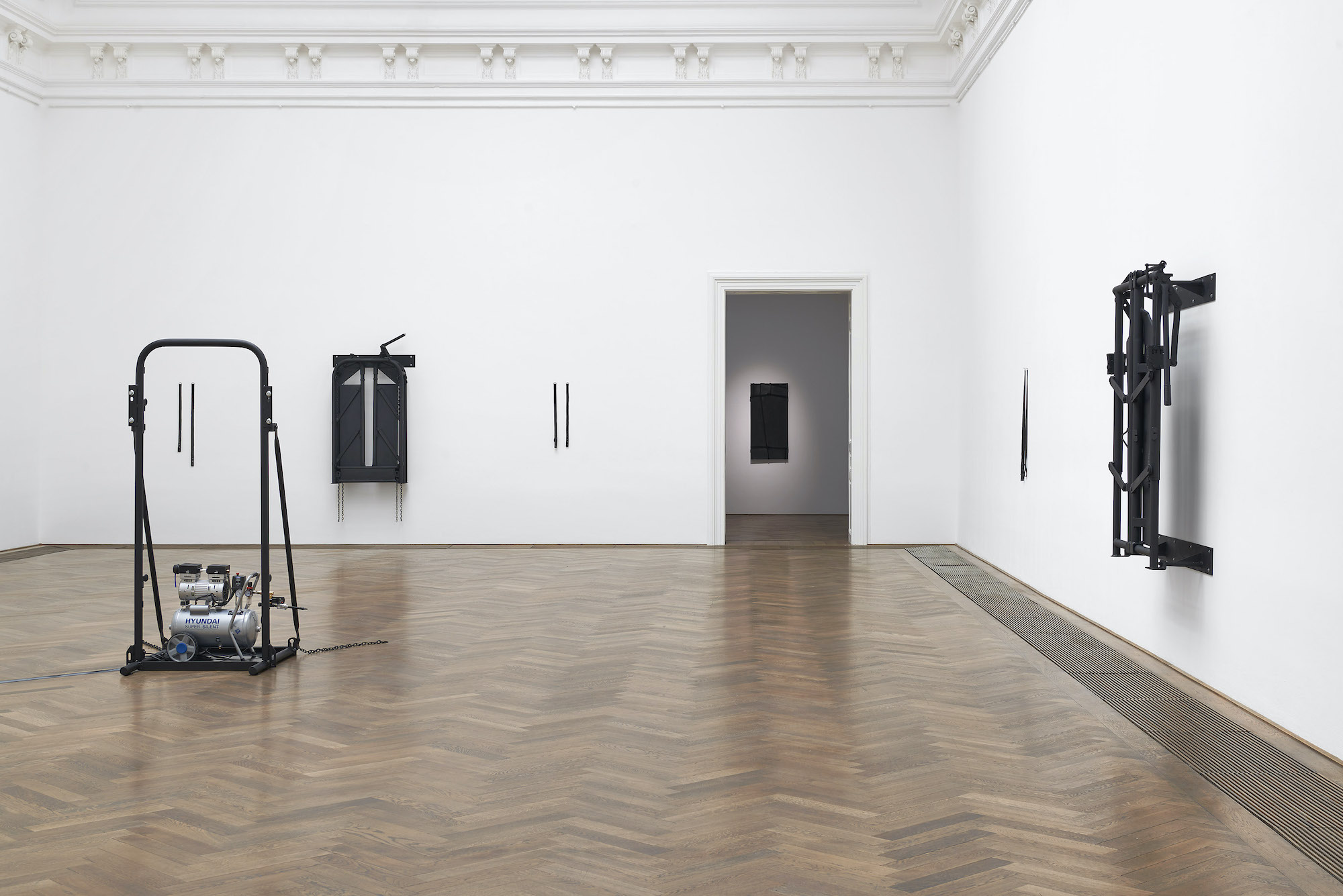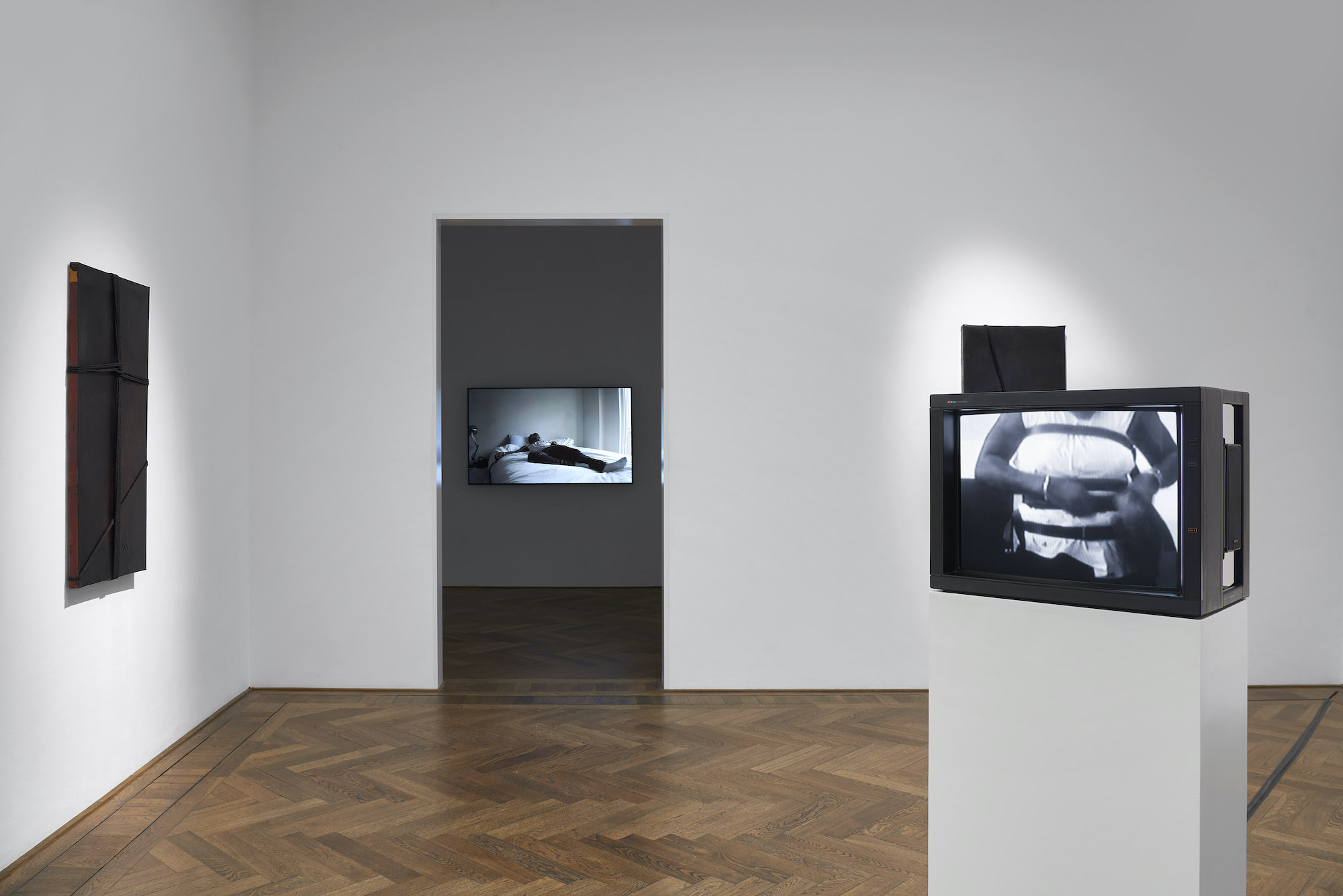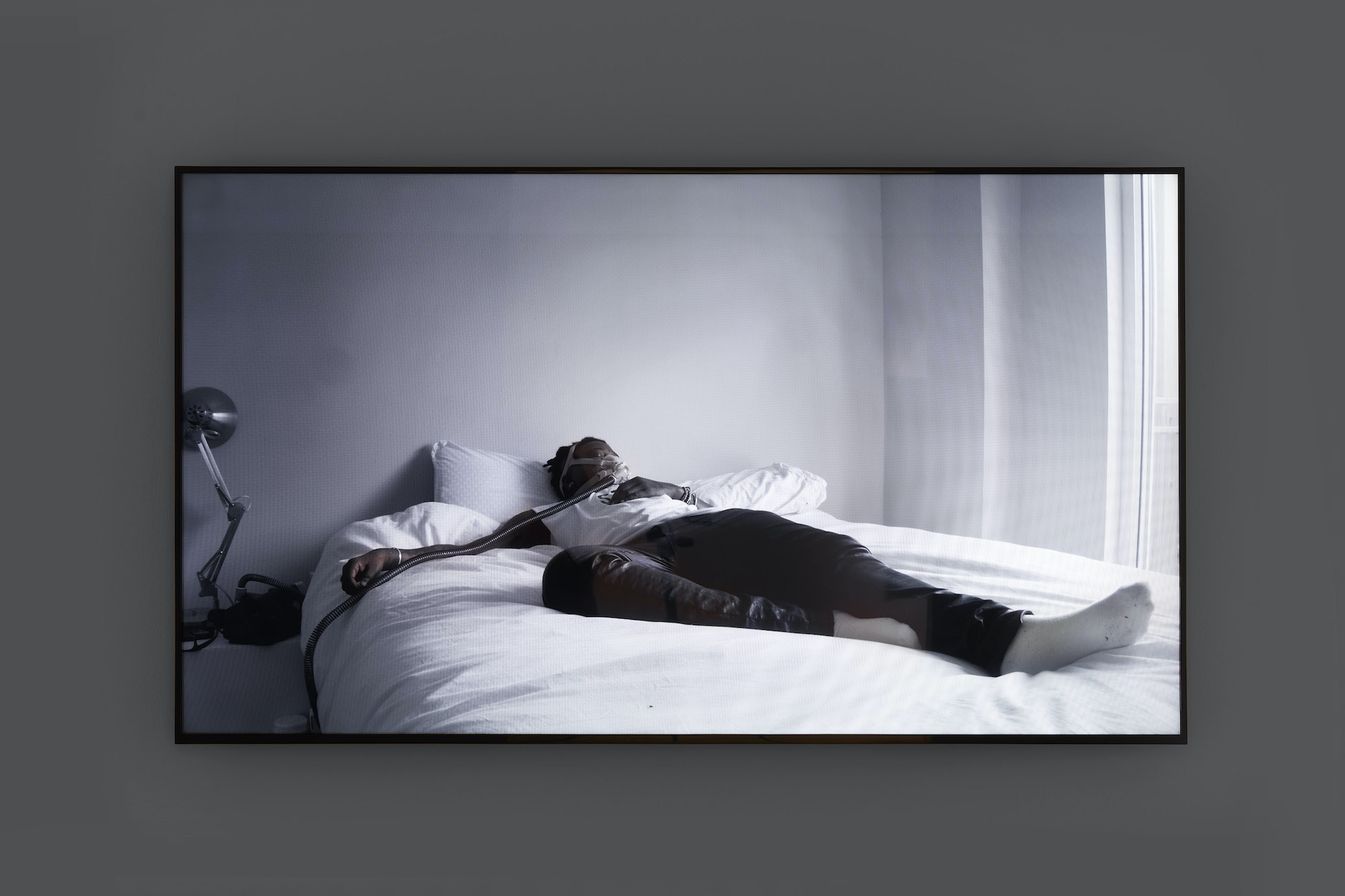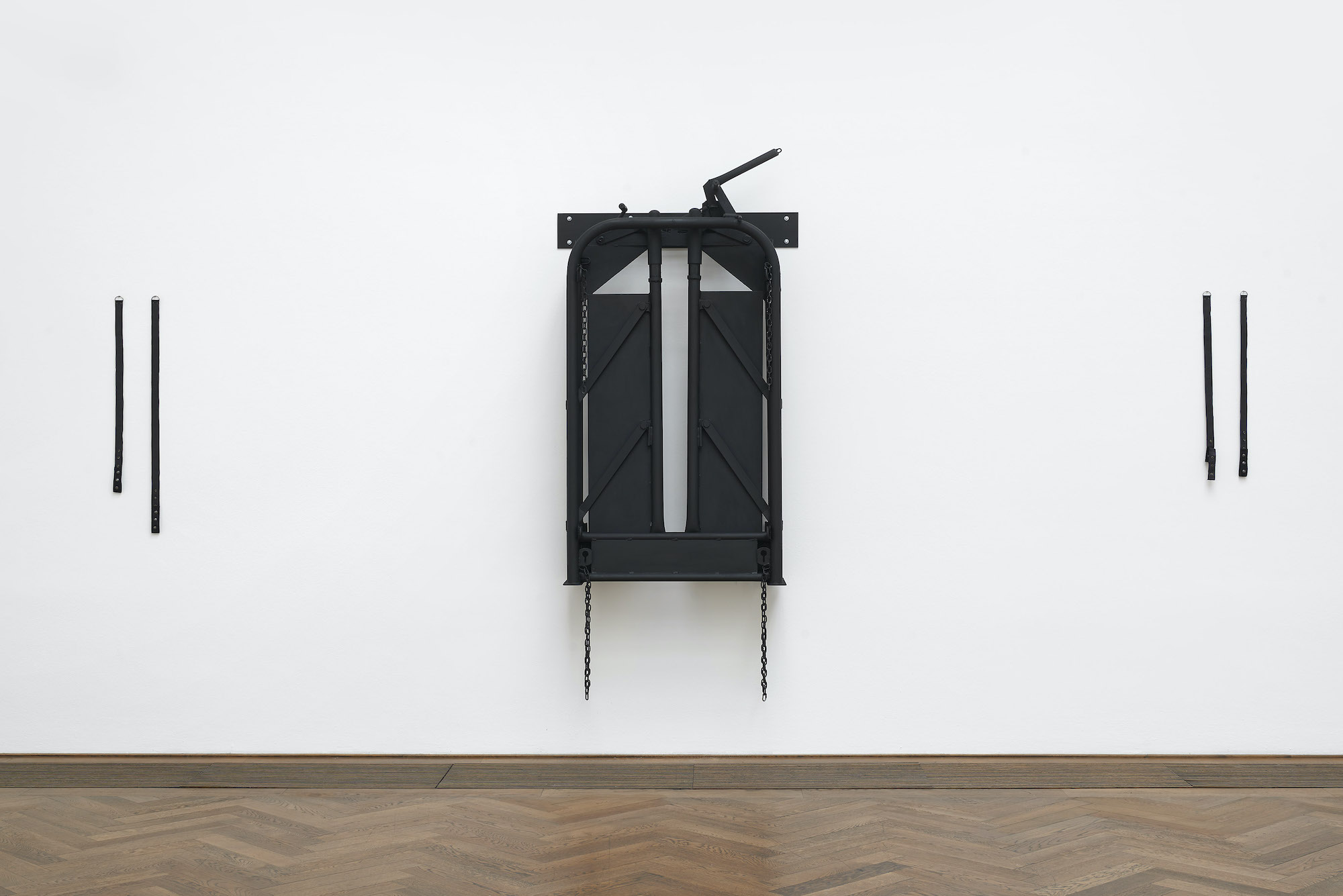Tiona Nekkia McClodden at Kunsthalle Basel
Tiona Nekkia McClodden, NEVER LET ME GO / V. irrevocable, installation detail, 2023 [photo: Philipp Hänger; courtesy of the artist and Kunsthalle Basel, Switzerland]
Share:
Beauty is not a luxury, rather it is a way of creating possibility in the space of enclosure, a radical act of subsistence, an embrace of our terribleness, a transfiguration of the given. It is a will to adorn, a proclivity for the baroque, and the love of too much.
—Saidiya Hartman
Renowned animal behaviorist Temple Grandin made a vivid impression on me as a teenager. She wore bright and flamboyantly embroidered western-style shirts and cloth cravats when giving academic lectures. She spoke about her autism without shame, from a place of uncompromising self-knowledge. She was obsessed with slaughterhouses. I felt a deep sense of relief at how bluntly she discussed the violence of industrialized death. I have the same feeling when listening to people who have nothing to gain from dissembling how much brutality is involved in being alive.
The first room of Tiona Nekkia McClodden’s solo exhibition, which occupies the second floor of Kunsthalle Basel, is devoted to cattle chute head gates. Grandin’s work contributed to the development of these structures, which restrict animal head movement and sensory input, making it easier and less stressful for cattle to be medically examined, to receive injections, or to be slaughtered. McClodden appropriated the industrial objects, removed their branding and ideological signaling—such as the phrase “Made in America”—coated the steel structures with wax, and then painted each a rich matte black.
Tiona Nekkia McClodden, A MERCY III, 2023 [photo: Philipp Hänger; courtesy of the artist and Kunsthalle Basel, Switzerland]
Tiona Nekkia McClodden, NEVER LET ME GO / V. irrevocable, 2023 [photo: Philipp Hänger; courtesy of the artist and Kunsthalle Basel, Switzerland]
According to the exhibition’s press release, McClodden’s painting-objects “emit an inexplicable violence,” and it’s true that a sensitive viewer might sense the force required to bend steel bars into shape or the desire for control implied by levers and chains. But to me, this work isn’t about inexplicable violence; it’s about mercy in a world so saturated with violence that, when people like Grandin become obsessed with how to attenuate it, they are perceived as inexplicably strange.
Mercy, McClodden clarifies in an interview with Maximilíano Durón from ARTNews, cannot be self-generated. Mercy is granted by someone who holds a position of absolute power over the body. “The head gates all have points of what I would call a bend that suggests a notion of mercy. This bend is just a slight curve … where the neck of the animal will be held,” McClodden writes. “It’s supposed to prompt the person who’s pulling [the gate] to stop.”1 These metal indentations instruct their user to grant mercy, like a safe word given form.
Tiona Nekkia McClodden, THE POETICS OF BEAUTY WILL INEVITABLY RESORT TO THE MOST BASE PLEADINGS AND OTHER WILES IN ORDER TO SECURE ITS RELEASE, installation view, 2023 [photo: Philipp Hänger; courtesy of the artist and Kunsthalle Basel, Switzerland]
In one corner of the room, a small razor blade is embedded in an immense wall. A collection of treated leather straps are installed loosely at large intervals, between the head gates. Each bears a phrase embossed into its surface, such as: A SINGLE MOMENT OF INATTENTION AND I FORGET TO BREATHE. These straps were used in a performance by McClodden. Displayed as quasi-paintings, they evoke the body of the cattle within the space and, by sublimating the violence into leather play, close the loop opened by the head gates. With this virtuosic formal gesture, McClodden folds the question of violence back on itself. The force applied to McClodden’s own body by these straps (made of cattle skin) is dispersed by the fact that this ritual is self-inflicted, part of a subcultural choreography. But the representation of force lingers, its totality left unabsorbed by the artist’s use of it.
In a second, smaller room, McClodden presents five paintings made with leather, cowhide, and rope tied using a Japanese bondage technique. The artist produces the paintings through a laborious process of dyeing, conditioning, and polishing. Richly textured, the works’ surfaces exude visceral discipline. McClodden employs the kinbaku-bi method for the rope bindings; that term translates to the beauty of tight binding. It’s incorporation into the work extends McClodden’s play with the multivalence of force, as the technique was first used in Japan to bind and torture captives and has since drifted into use in erotic bondage. Here, again, is that line between mercy at the hands of an absolute authority and voluntary submission to the kind of force that overwhelms the senses and brings release to the body.
Tiona Nekkia McClodden, THE POETICS OF BEAUTY WILL INEVITABLY RESORT TO THE MOST BASE PLEADINGS AND OTHER WILES IN ORDER TO SECURE ITS RELEASE, installation view, 2023 [photo: Philipp Hänger; courtesy of the artist and Kunsthalle Basel, Switzerland]
I settled on the floor of the small video projection room beside the second gallery, relieved to be given a figurative image to sink into, a momentary respite from McClodden’s rigorous formalism. DOUBLE BIND (2023) is a long shot of McClodden sleeping while attached to a continuous positive airway pressure (CPAP) machine, a medical device used to treat sleep apnea disorders. The camera is positioned at the foot of the artist’s double bed, which is next to a window. Light pours into the frame. I notice the tactile details of the scene. The bed is made, its duvet tucked neatly under the mattress. McClodden’s soft white cotton shirt rises and falls with each breath. The artist’s toes twitch slightly inside thick athletic socks. The CPAP device McClodden wears is at odds with the rest of this picture, an apparatus juxtaposed to the carefully constructed, comfortable restfulness of the room. Then, twenty minutes into the work, a ripple passes through the artist’s body. McClodden stops breathing, and the machine compensates by pushing air into the artist’s lungs through the tube. The moment is subtle, but it breaks my absorption in the image.
Tiona Nekkia McClodden, DOUBLE BIND, 2023 [photo: Philipp Hänger; courtesy of the artist and Kunsthalle Basel, Switzerland]
“When I shot it,” McClodden writes of DOUBLE BIND, “it was my first time seeing myself struggle to breathe. I had never seen this thing that people had observed me do. I stop breathing seven times per hour at night.” Sleep apnea drains the body by bringing it to the edge of asphyxiation repeatedly at a time when the body is at rest, when it needs to be able to relax. Those who suffer from it wake up exhausted, having experienced low blood oxygen levels, their immune systems weakened and made vulnerable by an inability to rest properly.
Outside the exhibition, in the Kunsthalle’s bookshop, McClodden recommends a slim volume to the viewer: Out of Breath: Vulnerability of Air in Contemporary Art (2022) by Caterina Albano. It was written in the context of the Covid-19 pandemic, when the privilege to breathe when and where one wished was suddenly curtailed by the rights of others to survive sharing breath with you. She reminds the reader that the body’s most consistent point of contact with the world around us is the intake of breath. Even before the pandemic, Albano argues, breathing marked the threshold between liveness and inertness. To be able to breathe, like being able to sleep and find release in surrender, is to be human.
Tiona Nekkia McClodden, THE POETICS OF BEAUTY WILL INEVITABLY RESORT TO THE MOST BASE PLEADINGS AND OTHER WILES IN ORDER TO SECURE ITS RELEASE, installation view, 2023 [photo: Philipp Hänger; courtesy of the artist and Kunsthalle Basel, Switzerland]
Natasha Marie Llorens is a Franco-American independent curator and writer based in Stockholm, where she is a professor of art and theory at the Royal Institute of Art. Llorens regularly contributes art criticism to e-flux agenda, and she has recently published with Artforum, frieze, CURA., Contemporary Art Stavanger, and La belle revue, among others. She holds a PhD in modern art history and comparative literature from Columbia University and an MA from the Center for Curatorial Studies at Bard College. She is currently at work on a book project about five experimental films from the 1960s/1970s in Algeria and collaborating on a research project about Algerian socialism with contemporary artist Massinissa Selmani. The first exhibition associated with this research is to open in Algiers in May 2023.
